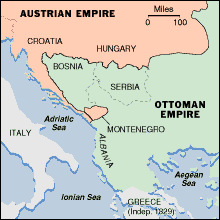
1815 to 1839: After the Congress of Vienna
The Ottoman Empire, having emerged from the Middle Ages predominant
in the Balkans, controlled Serbia and Bosnia and Herzegovina at its
northern fringes.
| |
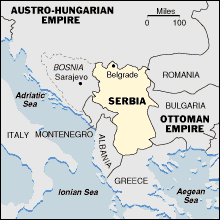
1914: Eve of the First World War
The Turks were driven from most of the Balkans in the 19th century and
were replaced by rivalrous European powers. With Russian patronage, an
independent Serbia was born alongside an Austrian-controlled Bosnia,
where a Serbian nationalist ignited World War I by assassinating the
Austrian crown prince.
|
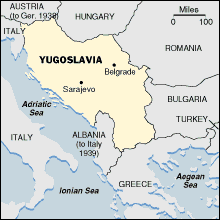
Between the Two World Wars
The Versailles conference created a unified kingdom of the south Slavs --
Yugoslavia. It encompassed Serbs, Croatians and Slovenians, with the
capital in Belgrade and the lion1s share of influence held by Serbs.
Bosnia's Muslims were not recognized as a distinct group.
| |
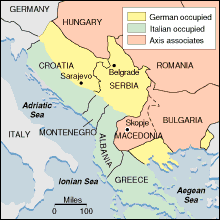
Nov. 1942: Height of Axis Occupation
The Axis powers occupied Yugoslavia, creating a puppet state in Croatia
ruled by local fascists who fought and butchered Serbs, Jews and Gypsies.
Yugoslav Communist partisans led by Tito, as well as Serbian royalists
known as Chetniks, fought the Nazis, and Tito emerged in control.
|
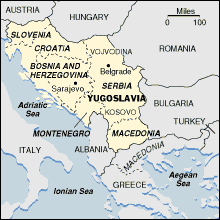
1945 to 1990: Cold War Stability
Under Tito, Yugoslavia held together as a federation of six autonomous
republics, although Serbs retained great influence, notably in the military.
As Communism collapsed, Serbia's President, Slobodan Milosevic, hastened
Yugoslavia's disintegration with a blatantly nationalistic appeal to Serbs.
| |
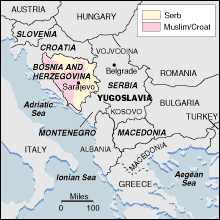
1991 to 1995: Open Warfare
Fighting broke out in 1991 when Slovenia and Croatia seceded, then spread
to Bosnia in 1992. After three years of bitter warfare characterized by
atrocities and the creation of hundreds of thousands of refugees, a
U.S.-sponsored peace accord for Bosnia was signed in Dayton, Ohio, in late 1995.
|
